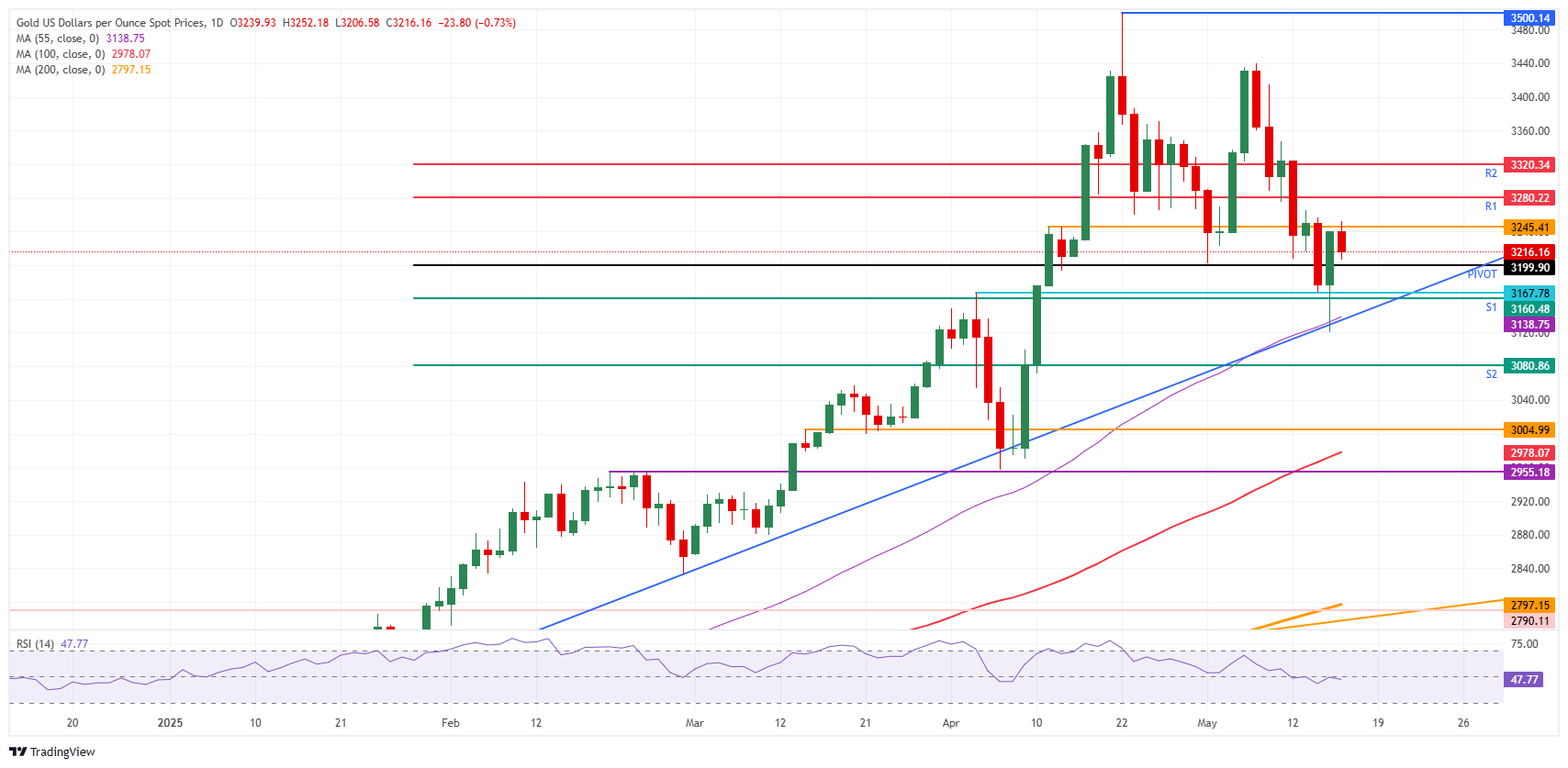Gold edges lower amid geopolitical, trade uncertainty
- Gold price edges lower on Friday after surging nearly 2% the previous day after the tragic breakdown in the Russia-Ukraine talks in Turkey.
- Meanwhile, questions arise about the stability and trustworthiness of the US Dollar.
- After a volatile week, Gold struggles to hold $3,200 on Friday.
Gold (XAU/USD) price edges lower and struggles to hold near the $3,200 level at the time of writing on Friday as multiple questions and concerns arise in markets and amongst traders. First and foremost, the Ukraine-Russia talks looked to be dead and buried even before Ukrainian President Volodymyr Zelenskyy shook hands with Turkish President Recep Tayyip Erdoğan on the tarmac at Ankara. Russian President Vladimir Putin didn’t attend himself and only sent some low-level diplomats, who were rather seen as Russia taunting and pestering Ukraine.
This spurred several world leaders to lash out at Russia, threatening with more severe sanctions to force President Putin to the negotiation table. Markets are bracing for comments from United States (US) President Donald Trump, who appears to be not amused with the scenery, according to Reuters.
Meanwhile, the US Dollar (USD) is being challenged by markets, which would be a tailwind for XAU/USD. Volatility “in US risk assets and the dollar will lead more international investors to consider hedging more of their dollar exposure and globally diversifying their asset allocations,” Mark Haefele, chief investment officer for the Swiss bank’s wealth management unit, said this week. “Gold remains an important diversifier,” Bloomberg reports.
Daily digest market movers: Geopolitical, trade talks, USD to drive Gold’s price
- Progress on trade negotiations between the US and China has also sapped appetite for haven demand, adding to bearish headwinds for Gold as the standoff between the world’s two largest economies led to a sharp rebound in risk assets this week, Reuters reports.
- Investors need to diversify and hedge “to increase certainty about the value of their assets, especially when they have non-dollar liabilities coming due,” Mark Haefele, chief investment officer for the Swiss bank’s wealth management unit, said. “There doesn’t need to be a seismic shift in US exceptionalism for these trends to manifest themselves.”, Bloomberg reports.
- Precious metals sector consolidations are facing some headwinds. A major Chinese Gold producer is scouting for acquisition opportunities worldwide, although the recent price volatility driven by global trade turmoil means it’s not rushing to secure deals, Bloomberg reports.
Gold Price Technical Analysis: Mixed bag
Headwinds and tailwinds, too many to sum up for Gold, are currently pushing the precious metal all over the place. It is no longer an easy picture, at least for now, and Gold is not one-directional as it was at the start of the year. Ultimately, the ‘last wind standing” will decide which direction Gold will head. Though for now, investors should keep looking at the $3,160 area to assess whether the Gold rally is still viable and intact.
On the upside, the pivotal technical level at $3,245 (April 1 high) is acting as resistance and could be difficult to reclaim. Once through there, the R1 resistance at $3,280 and the R2 resistance at $3,320 are the following levels to watch, though a major catalyst would be needed to get it there.
On the other side, the daily Pivot Point stands at $3,199, in line with the $3,200 big figure. In case that level does not hold on Friday, expect a move lower to test the support area around $3,160, with the April 3 high at $3,167 and the intraday S1 support at $ 3,160, before the 55-day Simple Moving Average (SMA) at $3,138.

XAU/USD: Daily Chart
Gold FAQs
Gold has played a key role in human’s history as it has been widely used as a store of value and medium of exchange. Currently, apart from its shine and usage for jewelry, the precious metal is widely seen as a safe-haven asset, meaning that it is considered a good investment during turbulent times. Gold is also widely seen as a hedge against inflation and against depreciating currencies as it doesn’t rely on any specific issuer or government.
Central banks are the biggest Gold holders. In their aim to support their currencies in turbulent times, central banks tend to diversify their reserves and buy Gold to improve the perceived strength of the economy and the currency. High Gold reserves can be a source of trust for a country’s solvency. Central banks added 1,136 tonnes of Gold worth around $70 billion to their reserves in 2022, according to data from the World Gold Council. This is the highest yearly purchase since records began. Central banks from emerging economies such as China, India and Turkey are quickly increasing their Gold reserves.
Gold has an inverse correlation with the US Dollar and US Treasuries, which are both major reserve and safe-haven assets. When the Dollar depreciates, Gold tends to rise, enabling investors and central banks to diversify their assets in turbulent times. Gold is also inversely correlated with risk assets. A rally in the stock market tends to weaken Gold price, while sell-offs in riskier markets tend to favor the precious metal.
The price can move due to a wide range of factors. Geopolitical instability or fears of a deep recession can quickly make Gold price escalate due to its safe-haven status. As a yield-less asset, Gold tends to rise with lower interest rates, while higher cost of money usually weighs down on the yellow metal. Still, most moves depend on how the US Dollar (USD) behaves as the asset is priced in dollars (XAU/USD). A strong Dollar tends to keep the price of Gold controlled, whereas a weaker Dollar is likely to push Gold prices up.

